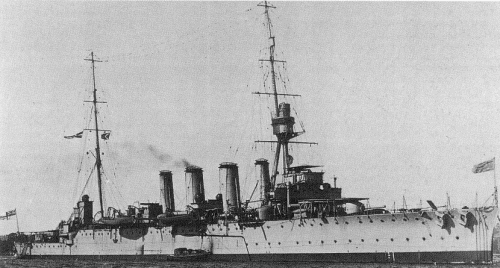
NAVYPEDIA
 Support the project with paypal
Support the project with paypal
Photo

Sydney 1920
Ships
| Name | No | Yard No | Builder | Laid down | Launched | Comp | Fate |
|---|---|---|---|---|---|---|---|
| Melbourne | 86, 93 | Cammell Laird, Birkenhead, UK | 14.4.1911 | 30.5.1912 | 1.1913 | sold for BU 12.1928 | |
| Sydney | A1, 52 | London & Glasgow Co, Glasgow, UK | 11.2.1911 | 29.8.1912 | 6.1913 | sold for BU 1929 | |
| Brisbane | Cockatoo DYd | 25.1.1913 | 30.9.1915 | 11.1916 | sold for BU 6.1936 |
Technical data
| Displacement normal, t | 5400 |
|---|---|
| Displacement full, t | 6000 |
| Length, m | 139.6 |
| Breadth, m | 14.9 |
| Draught, m | 4.90 |
| No of shafts | 4 |
| Machinery | 4 Parsons steam turbines, 12 Yarrow boilers |
| Power, h. p. | 25000 |
| Max speed, kts | 25.5 |
| Fuel, t | coal 1240 + oil 260 |
| Endurance, nm(kts) | 4500(16) |
| Armour, mm | belt: 51 on 25mm plating, deck: 38 - 10, CT: 102, gun shields: 102 |
| Armament | 8 x 1 - 152/50 BL Mk XI, 4 x 1 - 47/40 3pdr Hotchkiss Mk I, 2 - 533 TT (beam, sub) |
| Complement | 475 |
Standard scale images

Melbourne 1913
Graphics
Project history In the three cruisers authorised for 1911 the weaknesses of the preceding classes were eliminated. On virtually the same dimensions seakeeping was improved by extending the fo
In the three cruisers authorised for 1911 the weaknesses of the preceding classes were eliminated. On virtually the same dimensions seakeeping was improved by extending the forecastle aft for more than two-thirds of the length, and some side protection was worked in, all at the cost of only a slight increase in beam. A reduction in metacentric height also reduced rolling and improved shooting. The protective deck of the Bristol and Weymouth designs was retained, but only to maintain watertight integrity (10mm over most of its length, 19mm over machinery and 38mm over the steering gear). A shell penetrating this deck would still have to penetrate three decks first, and would probably have detonated by the time it reached the so-called 'splinter deck'. The weight saved on deck plating was devoted to a 51mm waterline belt of nickel steel on 25mm shell plating. The protection thus became part of the main structure of the ship, enabling weight to be saved on framing. As this arrangement of double plating could not be given a double curvature the midships section in the new design was slab-sided. There had been dissatisfaction with the high-velocity Mk.XI 152mm gun, and so the new cruisers had to be reverted to a RGF-designed 45cal lower-velocity gun, the Mk XII. It had the advantage of shooting more accurately and being nearly 2t lighter, with virtually the same range (12,700m), but only cruisers of 1912 Programme (Birmingham class) received new guns. The Chatham class could easily be distinguished from the Weymouths by their long forecastle deck and the 'plough' bow. Protection: Armoured belt protected ship at full length, its thickness was 76mm (summary) abreast machinery spaces and 51mm at ship ends. It extended to main deck (and to upper deck abreast machinery). Protective deck was 19mm thick over machinery and 38mm over steering gear. Its thickness over other ship parts was 10mm.
Modernizations
1915, Melbourne, Sydney: + 1 x 1 - 76/45 20cwt QF Mk I
1918, Melbourne, Sydney: CT was removed; + flying-off platform and 1 airplane
1919, Melbourne, Sydney: - flying-off platform and plane
Naval service
Brisbane served as TS since 1928.
 HOME
HOME FIGHTING SHIPS OF THE WORLD
FIGHTING SHIPS OF THE WORLD AUSTRALIA
AUSTRALIA CRUISERS
CRUISERS MELBOURNE light cruisers (1913-1916)
MELBOURNE light cruisers (1913-1916)
